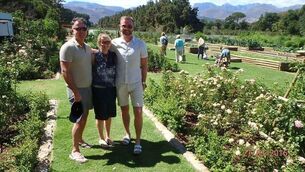First scents of spring are wafting in... here are some jobs to do in the garden

Winter honeysuckle provides great scent in the garden during winter
AND just like that it was February and St Brigid’s Day was upon us - and we even have a bank holiday to honour her this year.
The days are noticeably brighter and longer, and there are signs of spring all around.
January was a wet and cold month and not very conducive to gardening until the last few days when we caught a glimpse of some early spring sunshine and a few dry days to give us hope.
The garden for the most part is still sleeping but from now on there will be rumblings of new growth each day, with new buds appearing at ground level.
The birds are starting to build their nests in preparation for new life this spring, and glimpses of large twigs, moss and hay being ferried to nesting sites are becoming more common each day.
There are plenty of sweet scents to be taken in around the garden now, with Sarcococca, winter honeysuckle, mahonia, witchhazel and daphnes taking centre stage, with their sometimes subtle blooms which have the ability to pack a serious punch of perfume into the spring air.
There is lots of tidying up to be done in the garden in advance of the anticipated flush of new growth over the next few weeks.
If debris from the herbaceous layer is cleared and composted, then bulbs and early flowering perennials will be more visible and more easily admired. If perchance there are some bags of bulbs still lying around the shed in bags or boxes, do plant them as soon as possible, some may have rotted or dried out but some may well still flower, if a little later.
Bulbs left unplanted will simply dry out and turn to dust, they will not keep into the next growing season without a medium to grow in, so it is best to get them into the ground or a pot with compost.
Now is a good time to stock up on seeds at the start of the growing season. They need to be sorted through each year, and any older seed may not be viable but it is worth a try sowing unless they are very visibly damp and mouldy.
Having a glasshouse, a heated bench or a propagation tray is invaluable early in the growing season so that a head start can be made with starting seeds. If you do not have a lot of protected growing space, then it is best to wait until nature can provide the right temperatures as there are a few months yet until it will be feasible to start transplanting young plants outdoors.
With the days starting to lengthen, and in an attempt to maximize on the light, now is a good time to consider washing polytunnel plastic and glass in the greenhouse.

Moulds, mildews and green mossy growths can accumulate, particularly over the winter months in places that do not get much sun as it is much lower in the sky.
Using a mixture of equal parts cider vinegar and warm water, the acidity of the cider is great for cleaning surfaces which need to be rinsed off after application.
It is best to clean both inside and outside to ensure that the maximum light is achieved for optimum growing conditions.
In addition to improving light levels for good plant growth, this cleaning is beneficial in the control of pests and diseases in a protected growing environment as it will keep any overwintering eggs or larvae in check.
Use a soft brush or cloth to wipe away the winter debris, and for a polytunnel use an old bath towel or bed sheet for larger tunnels, tie a rope to either end and then two people can stand either side of the polytunnel outside and shimmy up and down to remove any dirt, debris and algal growth as you go.
The milder weather recently is encouraging growth to start and this also means that weeds are getting going, so when cleaning beds and borders now is a good time to get the weeds out, especially perennial weeds, before they gain too much ground, particularly creeping buttercup this year for me!
This ground cover weed sends out runners that colonize an area in no time and it seemed to cope particularly well with the drought last summer, going dormant and then resurfacing when the rain materialised in September!
The application of a mulch now will save lots of time and effort later in the growing season, and using an organic mulch like garden compost, bark or farmyard manure will help the soil to retain moisture over the summer months.
It also looks great, freshening up the soil and adding material for soil microbes to feed on, as well as nutrients to the soil which plants will ultimately benefit from.

Plant of the Week
Vinca major, or greater periwinkle, is an effective ground cover plant that flowers for about 9 or 10 months of the year starting about now.
It is an evergreen plant with a spreading habit, producing arching stems that spread out and layer themselves along the surface of the soil.
It produces star shaped flowers of blue or white and will flower best when planted in full sun, but will also grow in partial shade.
Preferring a moist, well-drained soil, it does not like things to get too dry so keep that in mind when choosing a spot.
If Vinca major likes where it is growing, it may become invasive, but generally it is easy to pull out and bring under control.







 App?
App?


